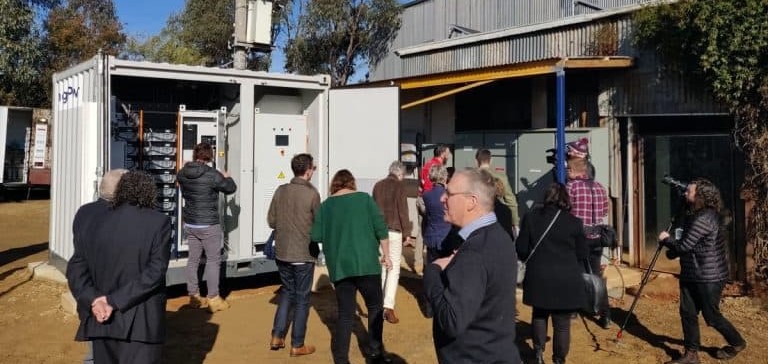
We provide general advice and support to help community energy groups decide the purpose, scope and network-related considerations for a community battery. We do this through our FAQs, fact sheets and community battery examples.
Photo credit: Yack01 community battery installed in Yackandandah, owned and operated by Indigo Power. Photo by Matthew Charles-Jones
2. Network data
A range of network data is available on our website to support the feasibility stage of community battery projects.
This includes:
This is a geographical map of our low and medium voltage network with information about the location of our distribution network assets, such as distribution substations.
Select the option to Access your Client’s Meter Data to request meter data on behalf of a third party. This may be relevant if you are considering a behind-the-meter community battery on an existing premise, for example a council building.
This page shows our reliability targets for short rural, long rural and urban feeders (powerlines). This is useful for understanding the average duration of planned and unplanned outages by type of feeder.
We give the Australian Energy Regulator an annual report on our electricity distribution network’s performance over the previous 12 months. This includes information about the reliability of:
- each feeder on our distribution network, relating to planned and unplanned outages
- the three types of network feeders (urban, short rural, long rural). This allows you to compare the actual reliability for your specific feeder against the average across our network.

Note: Feeders distribute electrical power from substations to local distribution transformers, or directly to consumers. Feeders typically operate at medium voltage levels, such as 22 kV and 11kV.
High voltage network data portal
This is a geographical map of our high voltage network (66kV and 22kV) with data, ratings, connections and information from our planning reports, including planned network upgrades, expansions and augmentations.
Historical load data on a zone substation level.
3. Connection services
After you develop a project scope and select a community-supported location, you can start the connection process with us. Our engineers must provide a technical assessment for the battery connection before we can offer a connection agreement.
To see the steps required to connect a 30kW to 1.5MW community battery, visit Connecting a community battery.
4. Network tariffs
Community batteries connecting directly to the grid (front-of-meter batteries) are typically assigned to commercial network tariffs based on their size and usage patterns.
On 1 July 2024, we introduced a neighbourhood storage tariff trial for front-of-meter community batteries that will take place over two years, until 30 June 2026. The purpose of the trial is to understand how community-scale storage systems, such as community batteries, will respond (charge, discharge) to price signals. This information will help us better manage our network.
The tariff structure has been designed for community-scale storage systems installed on our low-voltage network. There are two tariffs, based on inverter capacity:
- Medium – up to 250 kW
- Large – 250 kW to 1 MW

5. Letters of support
We can provide letters of support for community energy groups seeking government or third-party funding. We’ll first need details of your project, the scope and intended benefits.
The letter of support states we are aware of the project and that we can provide the above listed services, and/or what network tariff might apply to the project. We do not carry out any analysis or technical assessments to provide the letter of support.
Other resources
You can find more information about community batteries, including details of grant funding programs, on the following websites:
- ANU Neighbourhood Battery Knowledge Hub
- Australian Renewable Energy Agency (ARENA)’s Implementing Community Scale Batteries
- Victorian State Government Neighbourhood Batteries
More information and contact
For more information visit our Community Batteries webpage.
For any questions, please email our AusNet Community Energy Team at communityenergy@ausnetservices.com.au.
